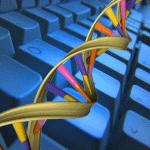Bioinformatics
|
30 june 2016 10:46:51 |
| THz frequency spectrum of protein-solvent interaction energy using a recurrence plot based wiener-khinchin method (Proteins: Structure, Function, and Bioinformatics) |
|
Tweet The dynamics of a protein and the water surrounding it, are coupled via non-bonded energy interactions. This coupling can exhibit a complex, nonlinear, and non-stationary nature. The THz frequency spectrum for this interaction energy characterizes both the vibration spectrum of the water hydrogen bond network, and the frequency range of large amplitude modes of proteins. We use a Recurrence Plot based Wiener-Khinchin method RPWK to calculate this spectrum, and the results are compared to those determined using the classical auto-covariance based Wiener-Khinchin method WK. The frequency spectra for the total non-bonded interaction energy extracted from molecular dynamics simulations between the ?-Lactamase Inhibitory Protein BLIP, and water molecules within a 10Å distance from the protein surface, are calculated at 150K, 200K, 250K, and 310K respectively. Similar calculations are also performed for the non-bonded interaction energy between the residues 49ASP, 53TYR, and 142PHE in BLIP, with water molecules within 10Å from each residue respectively at 150K, 200K, 250K, and 310K. A comparison of the results shows that RPWK performs better than WK, and is able to detect some frequency data points that WK fails to detect. This points to the importance of using methods capable of taking the complex nature of the protein-solvent energy landscape into consideration, and not to rely on standard linear methods. In general, RPWK can be a valuable addition to the analysis tools for protein molecular dynamics simulations. This article is protected by copyright. All rights reserved. |
| 183 viewsCategory: Biochemistry, Bioinformatics |
 Novel proteases from the genome of the carnivorous plant Drosera capensis: Structural prediction and comparative analysis (Proteins: Structure, Function, and Bioinformatics) Novel proteases from the genome of the carnivorous plant Drosera capensis: Structural prediction and comparative analysis (Proteins: Structure, Function, and Bioinformatics)Computational exploration of the binding mode of heme-dependent stimulators into the active catalytic domain of soluble guanylate cyclase (Proteins: Structure, Function, and Bioinformatics) 
|
| blog comments powered by Disqus |
MyJournals.org
The latest issues of all your favorite science journals on one page
The latest issues of all your favorite science journals on one page



